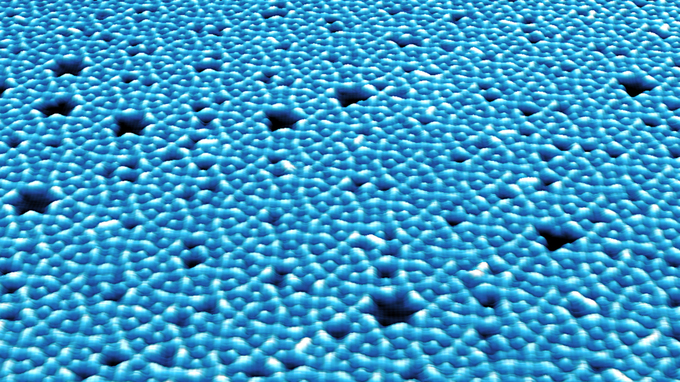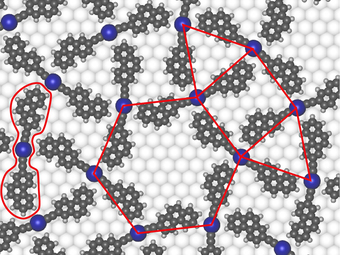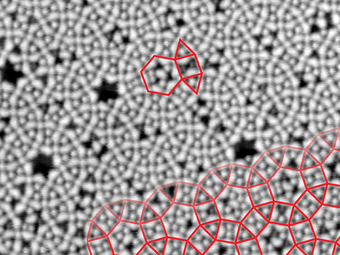Komplexe Parkettmuster, außergewöhnliche Materialien
Einfache organische Moleküle bilden komplexe Materialien durch Selbstorganisation
2018-01-22 – Nachrichten aus dem Physik-Department

Um eine Fläche mit gleichförmigen Kacheln lückenlos zu pflastern, kommen nur wenige geometrische Grundformen in Frage: Dreiecke, Vierecke und Sechsecke. Mit zwei oder mehr Kachelformen lassen sich wesentlich mehr und deutlich komplexere Muster erzeugen, die immer noch regelmäßig sind, die sogenannten Archimedischen Parkettierungen.
Auch Materialien können eine solche Parkettierung aufweisen. Diese Strukturen sind häufig mit ganz besonderen Eigenschaften verbunden, zum Beispiel mit außergewöhnlicher elektrischer Leitfähigkeit, spezieller Lichtreflektion oder extremer mechanischer Belastbarkeit. Doch es ist schwierig, solche Strukturen gezielt zu erzeugen. Dafür sind große molekulare Bausteine nötig, die nicht mit den konventionellen Herstellungsprozessen kompatibel sind.
Komplexes Parkettmuster durch Selbstorganisation

Bei einer Klasse supramolekularer Netzwerke ist nun einem internationalen Team um die Professoren Florian Klappenberger und Johannes Barth vom Lehrstuhl für Experimentalphysik an der TUM sowie Professor Mario Ruben vom Karlsruher Institut für Technologie ein Durchbruch gelungen: Sie brachten organische Moleküle dazu, sich zu größeren Bausteinen zu verbinden, die selbstorganisiert ein komplexes Parkettmuster bilden.
Als Ausgangsverbindung nutzten sie Ethynyl-Iodophenanthren, ein handliches organisches Molekül aus drei aneinandergekoppelten Kohlenstoffringen, das ein Iod- und ein Alkin-Ende besitzt. Auf einem Silbersubstrat bildet dieses Molekül zunächst ein regelmäßiges Netz mit großen sechseckigen Maschen.
Eine Wärmebehandlung setzt dann eine Abfolge chemischer Prozesse in Gang, die einen neuartigen, deutlich größeren Baustein erzeugen, der dann quasi automatisch und selbstorganisiert eine komplexe Schicht mit kleinen sechs-, vier- und dreieckigen Poren bildet. Dieses Muster wird in der Sprache der Geometrie als semireguläre 3.4.6.4 Parkettierung bezeichnet.
Einfache organische Bausteine bilden komplexe Materialien

„Unsere an der TUM durchgeführten Rastertunnelmikroskopie-Messungen zeigen deutlich, dass am Molekülumbau viele Reaktionen beteiligt sind, was normalerweise zu zahlreichen Abfallprodukten führt. Hier jedoch werden die Nebenprodukte wiederverwendet, so dass der Gesamtprozess mit großer Atomökonomie, das heißt mit nahezu hundertprozentiger Ausbeute, zuverlässig zum gewünschten Endprodukt führt“, erklärt Prof. Klappenberger.
Wie es dazu kommt, fanden die Forschenden durch weitere Experimente heraus. „Mit Hilfe röntgenspektroskopischer Messungen am Elektronenspeicherring BESSY II des Helmholtz-Zentrums Berlin konnten wir entschlüsseln, wie sich Iod vom Ausgangsstoff abspaltet, Wasserstoffatome zu neuen Plätzen wandern und die Alkin-Gruppen ein Silber-Atom einfangen“, berichtet Erstautor Yi-Qi Zhang.
Mit Hilfe des Silber-Atoms binden sich in der Folge zwei Ausgangsbausteine zu einem neuen, größeren Baustein aneinander. Die neuen Bausteine bilden anschließend die beobachtete komplexe Porenstruktur.
„Wir haben einen völlig neuen Weg entdeckt, um komplexe Materialien aus einfachen organischen Bausteinen herzustellen“, fasst Klappenberger zusammen. „Das ist wichtig, um Materialien mit neuen und extremen Eigenschaften gezielt synthetisieren zu können. Außerdem tragen diese Ergebnisse dazu bei, das spontane Auftauchen (Emergenz) von Komplexität in chemischen und biologischen Systemen besser zu verstehen.“
Die Arbeiten wurden gefördert mit Mitteln der Deutschen Forschungsgemeinschaft (im Rahmen des Exzellenzclusters Munich-Centre for Advanced Photonics sowie des Schwerpunktprogramms SPP 1459, des Transregio TR 88 3MET C5 und des DFG Projekts KL 2294/3) und des European Research Councils (ERC Advanced Grant MolArt). Die Synthese und Charakterisierung der Moleküle wurden in der Karlsruhe Nano Micro Facility durchgeführt.
Veröffentlichung
Verwandte Meldung
- Eingesperrte Moleküle offenbaren ihre Thermodynamik – 2015-02-26